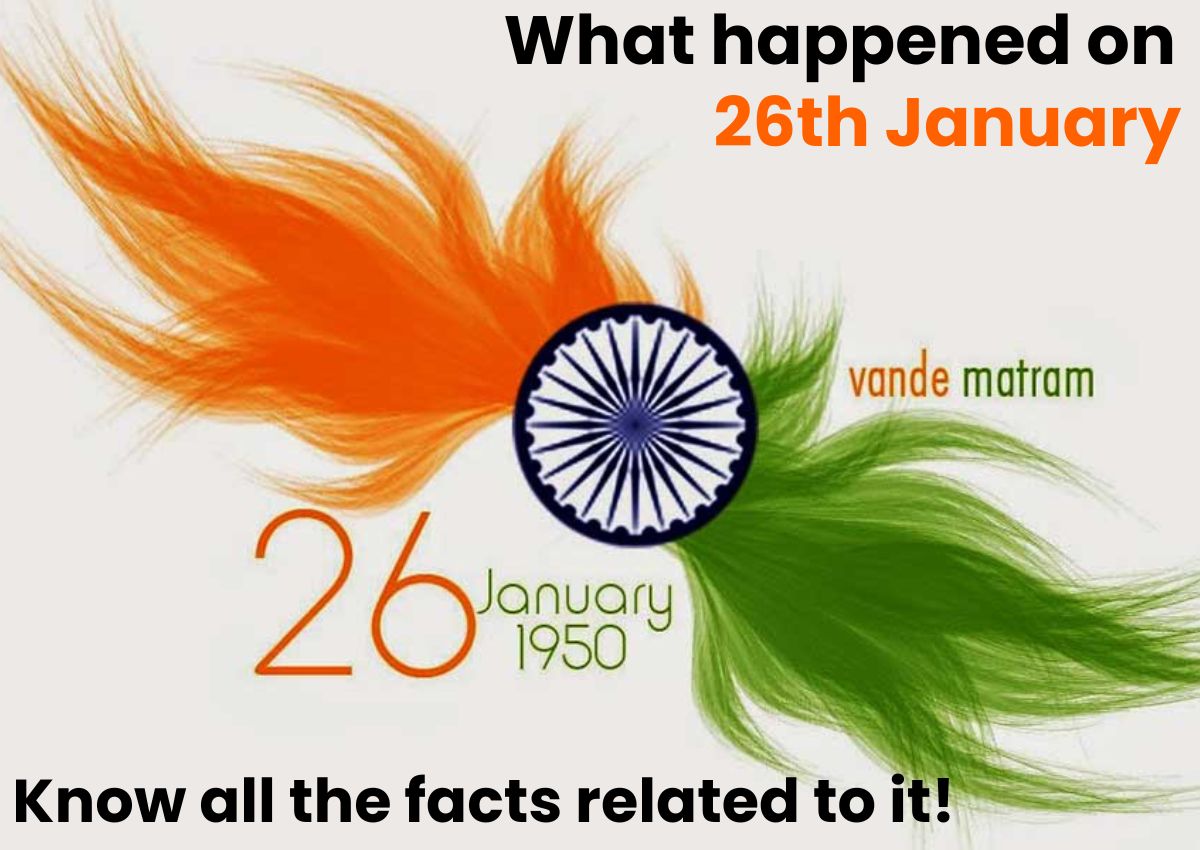Every year we all celebrate Republic Day on 26th January, but do we all know what happened on 26 January? and why do we consider 26 January as Republic Day? Through this article we will tell you what happened on 26 January?
On 26 January 1950, the Indian Constitution was formally adopted, and that event is celebrated as Republic Day. India became independent from the British Raj in 1947, but the Indian Constitution did not come into effect until 26 January 1950, making India a sovereign state and established as a republic.
What happened on 26th January?
The Constitution of India, the world’s largest written constitution with 395 articles and 8 schedules, was promulgated on 26 January. However, in India the date of 26 January is remembered not only for Republic Day but also for some other historical events. What happened on 26th January? Based on this, in this article you will get information about all the historical facts related to this day, so read this article till the end.
Establishment of National Memorial ‘Amar Jawan Jyoti’ on January 26, 1972

- Amar Jawan Jyoti was built during the 1971 Indo-Pak war as a memorial to the Indian soldiers martyred in battle. After this war, the nation of Bangladesh was formed with the cooperation of India.
- It was established on 26 January 1972 by the Prime Minister Indira Gandhi.
- Amar Jawan Jyoti is a memorial surmounted by an inverted beret and a soldier’s helmet. An eternal flame is also burning along with it.
- It is noteworthy that after 50 years, the flame of Amar Jawan Jyoti at India Gate was converted into the flame of the National War Memorial on 21 January 2022.
Resignation of the first and last Governor General of independent India – January 26, 1950
- Chakravarti Rajagopalachari, popularly known as Rajaji, was the first Indian Governor-General of independent India. After partition, Rajagopalachari was appointed the Governor of West Bengal.
- Before Mountbatten left India in June 1948, Rajagopalachari was given the post of Governor General. He held this post till January 26, 1950, when the Indian Constitution came into force and the country became a republic.
- On January 26, 1950, Chakravarti Rajagopalachari, the first and last Governor-General of independent India, resigned from his post.
- After this Dr. Rajendra Prasad became the first President of the country.
The Ashoka Pillar was adopted as the ‘national symbol’ on 26 January 1950

- The Constitution of India, which was adopted by the Constituent Assembly on November 26, 1949, came into force on January 26, 1950.
- This completed India’s movement towards becoming an independent republic with a democratic government system.
- 26 January was also chosen as the day to celebrate Republic Day because it was on this day that the Indian National Congress (INC) declared Indian independence in 1930.
- On January 26, 1950, the emblem of the Lion of Ashoka placed above the motto “Satyameva Jayate” was adopted as the state emblem of India. The national emblem is an adaptation of the Lion Capital, which was originally found atop the Ashoka Pillar at Sarnath, established in 250 BC.
- It is the national emblem of India and the official seal of the Republic of India.
Purna Swaraj Day – 26 January 1930
- After Jawaharlal Nehru proposed complete independence in the Lahore session on 26 January 1930, the Indian National Congress President declared it as Independence Resolution Day.
- Mahatma Gandhi named 26 January as ‘Freedom Resolution Day’.
- From 1931 until the country gained independence in 1947, every year January 26 was celebrated as Independence Day throughout the country.
Death of Humayun – January 26, 1556
- Mughal emperor Humayun died on January 26, 1556. On the evening of January 24, 1556, King Humayun Din was sitting on the terrace of his library in the building called Panah, also known as Sher Mandal.
- Mughal Emperor Humayun was discussing with his advisors and astrologers regarding holding a court at the time of appearance of Venus.
- He slipped while descending the stairs to attend evening Friday prayers, resulting in his death.
What is Republic Day of India?
- Republic Day is one of the Indian national holidays and commemorates the enactment of the Constitution of India, which took place on January 26, 1950.
- India gained independence from Britain on August 15, 1947 (which is celebrated as a separate national holiday), but for its first three years the country was largely governed by the Government of India Act of 1935.
- Soon after the declaration of independence, a Constituent Assembly elected by provincial assemblies drafted a constitution that played a key role in governing the newly independent nation. After taking more than two years, the Constitution of India was completed, and the independent democratic government of India was established.
- 26 January was chosen as the official enactment date as the acceptance of the Purna Swaraj (complete self-rule) declaration of independence by the Indian National Congress in 1930, considered the first concrete step towards independence from Britain.
- With the Constitution of 1950, the country was officially known as the Republic of India – a “sovereign socialist secular democratic republic” which, according to its Preamble, “secures to all its citizens justice, liberty, equality and fraternity “.
Republic day celebration
Republic Day is celebrated with great enthusiasm throughout the country. The national flag is hoisted by the President, followed by a spectacular military and cultural display of tableaux from various states and government departments.
The President of India also awards Param Vir Chakra, Ashok Chakra and Veer Chakra to the brave soldiers and Padma awards are also given to the deserving citizens of the country.
A huge parade is held in New Delhi, which includes cultural, historical and military displays. Before the parade, the Prime Minister lays a wreath at the arched war memorial called Amar Jawan Jyoti and observes a moment of silence in the memory of the martyred soldiers.



